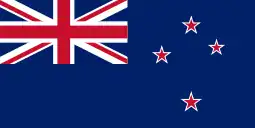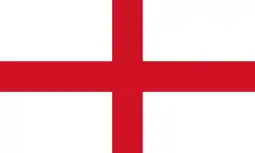East Africa cricket team
The East Africa cricket team was a team representing the countries of Kenya, Uganda, Tanzania and later Zambia. Their first game was against Rhodesia in 1951. East Africa appeared in the 1975 World Cup[4] and the 1979, 1982 and 1986 ICC Trophies. In the last two of these Kenya was represented in its own right, so that East Africa was effectively a Ugandan, Tanzanian and Zambian team.
 | |||||||
| Team information | |||||||
|---|---|---|---|---|---|---|---|
| Established | 1951 | ||||||
| Last match | v | ||||||
| International Cricket Council | |||||||
| ICC status | Former member (1966–1989) | ||||||
| ICC region | Africa | ||||||
| One Day Internationals | |||||||
| First ODI | v | ||||||
| Last ODI | v | ||||||
| |||||||
| World Cup appearances | 1 (first in 1975) | ||||||
| Best result | Group stage | ||||||
| As of 2 January 2019 | |||||||
East Africa was an associate member of the ICC from 1966 to 1989, after which its place was taken by East and Central Africa.
History
Cricket in the area began following British colonisation in the late nineteenth century. Most games were played on an 'officials vs settlers' basis initially, with no inter-territorial games being played. After the influx of Indian labourers into Africa to build the region's railway network the popularity of cricket expanded and by the end of World War II was one of the most played sports in the area.[5] Consequently, the East Africa Cricket Conference was founded in 1951 as the governing body for cricket in the region. It administered the inter-colonial matches between its initial three member countries of Kenya, Uganda, Tanganyika.[6] Later that year a combined team of the East African countries hosted a tour by the Rhodesian cricket team.[7]
East Africa's next recorded match was in 1956 against a visiting Pakistani XI. Under the captaincy of Denis Dawson (brother of South African test player Ossie Dawson) the East Africans were defeated in a 3-day match by 8 wickets.[8] The next year in a match against the touring Sunder Cricket Club the East Africans were defeated by 9 wickets.[9] In 1958 a South African team of non-European players toured the region and played one match against East Africa in Nairobi. This time captained by Malcolm Ronaldson, a former first-class player for Eastern Province, East Africa was beaten in the three day match by the South African Non-Europeans by 7 wickets.[10]
East Africa played several touring teams in the 1960s. In 1962 they played two games against the Commonwealth XI cricket team. In the first in Nairobi (10 to 12 February 1962) the East Africans were beaten by 20 runs.[11] The match was best remembered by a fast paced unbeaten century by Basil D'Oliviera in the Commonwealth team's second innings.[12] In the second match in October, also in Nairobi, the Commonwealth team beat East Africa by 118 runs.[13] The Marylebone Cricket Club (MCC) toured in 1963/4 playing three games in Uganda, one in Tanganyika and seven in Kenya. One of the games was against the East African team in Kampala where the MCC won by an innings and 71 runs.[14] In August 1967 India toured and played one 3-day first-class match. India won by 8 wickets.[15] An International XI of English first-class players visited in 1968 and played a 3-day match against East Africa in Nairobi. The match was drawn.[16]
East Africa toured England in June and July 1972, playing 18 matches against domestic teams, including a six-wicket victory against North Wales. None of the matches had first-class status.[17] The MCC toured East Africa again in 1973/74. In December 1973 they played two matches in Zambia followed by two more in Tanzania then four in Kenya. Their one match against the full East African team, which had first-class status, resulted in a 237-run victory for the MCC.[18] East Africa were invited to participate in the inaugural Cricket World Cup in 1975. Before the tournament began the teams participation was in doubt after Tanzania threatened to withhold players from touring England in protest of the British & Irish Lions rugby team touring Apartheid South Africa in 1974.[19] The inclusion of East Africa was seen as an important feature of the world cup due to a team from Africa being seen as necessary to signify the tournament as truly worldwide. The two strongest cricketing nations in Africa, South Africa and Rhodesia, selected players based on race and were excluded as part of a sporting boycott resulting in East Africa representing the continent. The team struggled and lost all three matches.[20] In 1978 the Minor Counties Cricket Association toured Kenya with seven matches there, two of which were against East Africa. The first was a 60 over match where the Minor Counties won by 8 wickets.[21] A scheduled 3-day match was abandoned without any play.[22]
Kenya broke away from the East Africa team in 1981 to join the ICC as an associate member in their own right.[23] In 1989, East Africa was reconfigured as East and Central Africa (representing Uganda, Tanzania, Zambia, and Malawi).
Tournament history
World Cup
Records
One Day Internationals
- Highest team total: 128/8 (60.0) vs.
 New Zealand, 7 June 1975
New Zealand, 7 June 1975 - Highest individual score: 45 (123), Frasat Ali vs.
 New Zealand, 7 June 1975
New Zealand, 7 June 1975 - Best innings bowling: 3/63 (12.0), Zulfiqar Ali vs.
 England, 14 June 1975
England, 14 June 1975
| ODI records versus other nations[32] | |||||||
|---|---|---|---|---|---|---|---|
| Opposition | M | W | L | Tie | NR | Win% | |
| 1 | 0 | 1 | 0 | 0 | 0.00% | ||
| 1 | 0 | 1 | 0 | 0 | 0.00% | ||
| 1 | 0 | 1 | 0 | 0 | 0.00% | ||
See also
Notes
- "Fixtures, Schedule | Global | ESPNcricinfo". Cricinfo. Retrieved 1 November 2018.
- "ODI matches - Team records". ESPNcricinfo.
- "Records / One-Day Internationals / Team records / Results summary". ESPN Cricinfo. Retrieved 20 February 2015.
- "West Indies as separate cricketing countries?". Emerging Cricket. Retrieved 8 July 2020.
- Bowen 1970, pp. 194.
- Bowen 1970, pp. 361.
- Bowen 1970, pp. 359.
- "East Africa v Pakistan Cricket Writers' XI". Cricket Archive. Retrieved 21 December 2022.
- "East Africa v Sunder Cricket Club". Cricket Archive. Retrieved 19 November 2022.
- "East Africa v South African Non-Europeans". Cricket Archive. Retrieved 19 November 2022.
- "East Africa v International XI". Cricket Archive. Retrieved 17 November 2022.
- "D'Oliviera Hits Out". The Press. Vol. CI, no. 29746. 13 February 1962. p. 15.
- "Century". The Press. Vol. CI, no. 29943. 3 October 1962. p. 19.
- "East Africa v Marylebone Cricket Club". Cricket Archive. Retrieved 17 November 2022.
- "East Africa v India". Cricket Archive. Retrieved 17 November 2022.
- "East Africa v International XI". Cricket Archive. Retrieved 17 November 2022.
- "North Wales v East Africa". Cricket Archive. Retrieved 18 November 2022.
- "East Africa v Marylebone Cricket Club". Cricinfo. Retrieved 17 November 2022.
- "N.Z. cricketers to play E. Africa". The Press. Vol. CXIV, no. 33596. 26 July 1974. p. 20.
- Cozier, Tony. "West Indies victory heralds a new era". Cricinfo. Retrieved 21 December 2022.
- "East Africa v Minor Counties". Cricket Archive. Retrieved 17 November 2022.
- "East Africa v Minor Counties". Cricket Archive. Retrieved 17 November 2022.
- Kenya at Cricket Archive
- "Prudential World Cup 1975". ESPN Cricinfo. Retrieved 20 February 2015.
- "Prudential World Cup 1979". ESPN Cricinfo. Retrieved 20 February 2015.
- "Prudential World Cup 1983". ESPN Cricinfo. Retrieved 20 February 2015.
- "Reliance World Cup 1987/88". ESPN Cricinfo. Retrieved 20 February 2015.
- "In the International Spotlight…Tanzania Cricket". 2 January 2009. Retrieved 20 February 2015.
- "ICC TROPHY, 1979: ENGLAND". ESPN Cricinfo. Retrieved 20 February 2015.
- "ICC TROPHY, 1982: ENGLAND". ESPN Cricinfo. Retrieved 20 February 2015.
- "1986 ICC Trophy in England: ENGLAND". ESPN Cricinfo. Retrieved 20 February 2015.
- "Records / East Africa / One-Day Internationals / Result summary". ESPNcricinfo. Archived from the original on 21 December 2015. Retrieved 6 February 2016.
References
- Bowen, Rowland (1970). Cricket: a History of Its Growth and Development Throughout the World. London: Eyre & Spottiswoode. ISBN 9780413278609.